Wacom Cintiq 21UX Review
Wacom Cintiq 21UX
With its largest Cintiq graphics tablet, Wacom marries the stylus talents of its award-winning Intuos 4 to a 21in IPS monitor for stunning results.
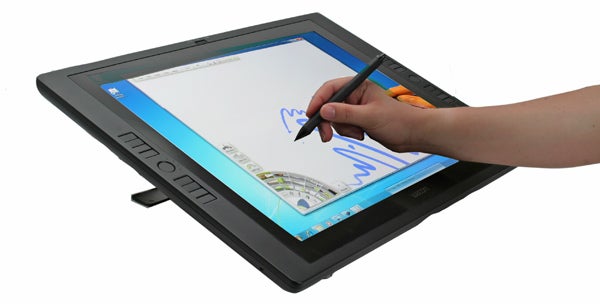
Verdict
Pros
- Similar experience to drawing on paper
- Beautiful IPS display, excellent build
- Matt glass layer doesn't reflect
- Fully and easily adjustable
- Generous, intuitive controls
Cons
- Expensive
- 1600 x 1200 resolution
- No hardware display profiles/presets
- Heavy
Key Specifications
- Review Price: £1565.58
- 21.3in 1600x1200 IPS panel
- Intuos 4 pen, controls and nibs
- 2048 pressure levels
- Matt glass protective layer
- Fully adjustable to flat or upright
Until recent competition from Hanvon, Wacom was the default choice for any digital artist or designer looking for a graphics tablet. Indeed, we gave the company’s latest Intuos 4 a whopping ten out of ten and our top Editor’s Choice award. With a tablet that’s already that good, how could it possibly get any better? Well, being able to see what you’re drawing on the actual tablet is always nice, and Wacom has its Cintiq line for exactly this reason. 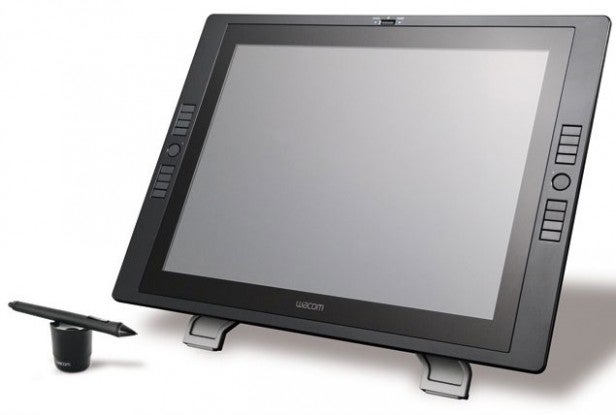
Essentially combining a graphics tablet and a monitor, the Cintiqs aim to give you the best of everything, allowing you to draw, sketch and doodle on their lightly textured surface just like you would on a piece of paper, and instantly displaying the results on their high-quality IPS panels. However, when we reviewed the Intuos 4, the Cintiq line was outdated, as it still used the tablet tech of the older Intuos 3. Now Wacom has rectified this, and its latest Cintiq 21UX sports all the specs and refinements of its newest Intuos stablemate. Does this make it the best graphics tool available?
First, let’s talk models. As Wacom hasn’t updated its smaller 12.1in 12WX, if you want the extra pressure sensitivity and features of the Intuos 4 on a Cintiq, the 21.3in 21UX is your only choice. It’s big and – at around £1600 – doesn’t come cheap, so let’s find out if it’s worth the outlay. 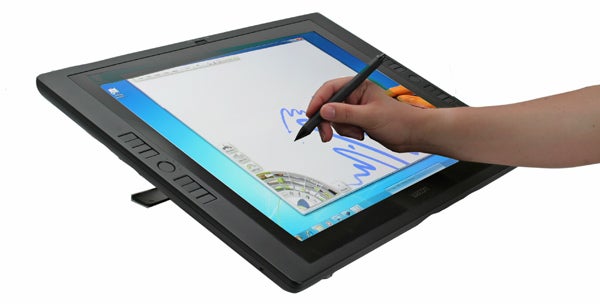
Thankfully, you can feel every penny of that money when you take the 21UX out of the box. Mind you, at 10.2kg that’s not the easiest feat and this tablet is far from portable. Its weight is reflected in the brick-like solidity of the tablet and the quality of the metal stand. The tablet itself is finished in smooth matt black plastic, which looks stylish and feels both rugged and pleasant to the touch. In combination with nicely rounded curves, it’s a pleasure to hold, and happy to rest on your lap (as long as you’re not bothered by its weight). 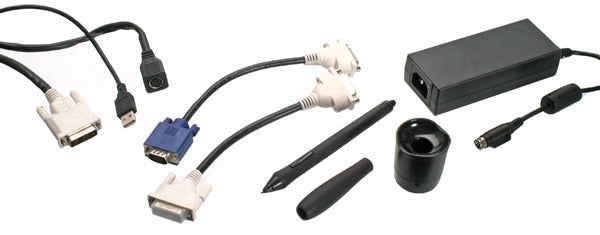
Out of the box, you’ll find: a pen with base that doubles as nib holder; the tablet itself, with a thick captive cable that terminates in data, video and power plugs; the external power brick; video adapters (including DVI to VGA and DVI-D to DVI-D); and the heavy metal stand. It’s a shame the tablet’s cable can’t be detached. And it would have been nice to see an HDMI adapter to go with this Cintiq’s native DVI connector and VGA adapter. The DVI conversion cable could also have done with being a little longer so that it could have done double duty as an extension, but otherwise we have no complaints.
Setting the tablet up is as easy as can be. Simply place the base on your desk and slide the tablet into it. A protrusion around the cable on the Cintiq’s back slots neatly into the base’s curved cradle, a bit like a ball and socket joint. Together with the stand’s ingenious tilting design, this makes for an incredibly flexible setup. The ‘circle and socket’ arrangement allows the tablet to be docked or removed without any effort, and also lets you rotate it whichever way you want. We wish there was a little more resistance to tell us when the tablet is in its perfectly level horizontal position. However, once you do find the perfect level, you can lock the screen in place using two provided screws.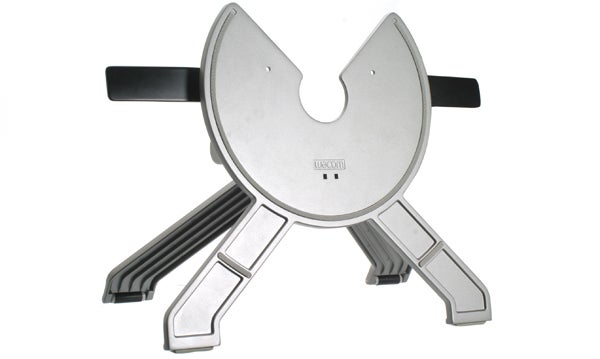
Meanwhile, the stand’s unique folding legs allow the tablet to be tilted as flat as you like, so that you can draw on it just as you would on a piece of paper. These tilt adjustments are made by gently pulling two levers to the sides of the tablet, which then allows you to slide back the base’s rear feet. This also means that ‘flattening’ the Cintiq won’t require you to remove any items that might be in front of it, such as your keyboard and mouse. In its upright position (mainly when being used as a monitor) the 21UX is always at a bit of an angle though. Unlike your average monitor, it can’t stand completely straight but makes for comfortable viewing regardless.
The monitor component of the Cintiq 21UX is a 21.3in, 1,600 by 1,200 panel. That’s right, as all you haters of widescreen displays will have noticed, that gives it an aspect ratio of 4:3 rather than the usual 16:10 found on professional monitors these days, or the 16:9 that’s (unfortunately) becoming ever-more common. In fact, if you’re after a square screen, this is one of the few new options on the market.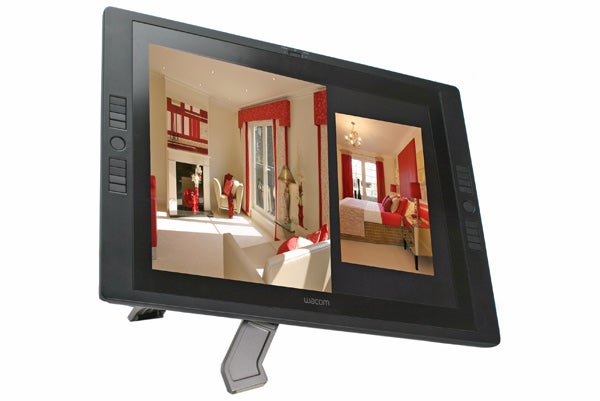
Its old school aspect ratio will probably be the most controversial decision about this Cintiq. Its smaller 12in sibling is a widescreen affair, so why go for an ‘outdated’ square screen on the top-end model? Part of it is probably to make it more manageable as a tablet, especially when rotating it or using it on your lap. Maybe it’s also to cater to the established fanbase
who are used to this resolution on the older models. To be honest though, we would far rather have seen a 1,920 x 1,200 panel here. It’s the industry standard, and going back to less simply feels restrictive.
It’s a real shame too, since otherwise the 21UX holds up well as a monitor. As you would expect at this price point, it doesn’t use a cheap and shoddy TN panel. Instead you’ll find a proper high-end IPS panel, with excellent viewing angles, dark detailing and colour characteristics. Despite a glass panel protecting it from wear and tear, it has a matt finish so reflections aren’t a problem.
Once calibrated this screen is a joy to use for graphics work. Viewing angles are nearly as good as it gets, with no significant contrast or colour shift no matter from where you’re viewing the screen – an essential attribute on a panel you’ll be using in various states of tilt. Colours are rich without being oversaturated, and though blacks are certainly far from the deepest we’ve seen, the panel easily distinguished between even the darkest grey shades without losing significant white purity, and doesn’t suffer from backlight bleed or clouding (it’s worth noting, by the way, that in order to enable brightness and contrast control on the Cintiq, the colour temperature needs to be set to Custom).
Nor are there any nasty artefacts, with smooth gradients and sharp text. We even found the 21UX’s response time holds up well, so all but the most avid gamers won’t be left wanting. And that’s a good thing, as some games (like Plants versus Zombies and other mouse-only titles) are a whole new level of fun when played with a stylus on a flat surface. Even trying an FPS or two is a very different and interesting experience.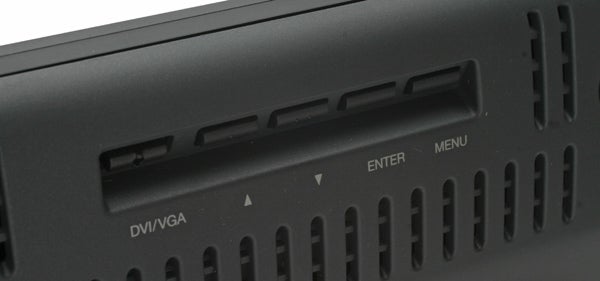
Unfortunately the Cintiq’s screen controls and OSD aren’t exactly the most ergonomic or aesthetically-pleasing we’ve come across. The buttons are tucked away behind the bezel, and none of them act as a shortcut. You can’t, for example, select presets without entering the OSD. Even then, all the ‘presets’ you’re offered are choices between colour temperatures. The OSD itself, meanwhile, is fairly straightforward but looks like something from 1992.
Still, these are all minor complaints really, and don’t detract from a good monitor experience. Just remember that if you intend to use the 4:3 Cintiq as your main monitor, widescreen movies will have black bars the size of placards, and we do hold the 21UX’s lack of horizontal resolution against it.
Getting to the tablet component of the Cintiq 21UX, this is, for all intents and purposes, an Intuos 4 with a few minor differences. So for all the nitty-gritty details, we suggest you have a read of our comprehensive review of that model. However, for the rest of you, and to see just what’s changed, let’s go through the basics. 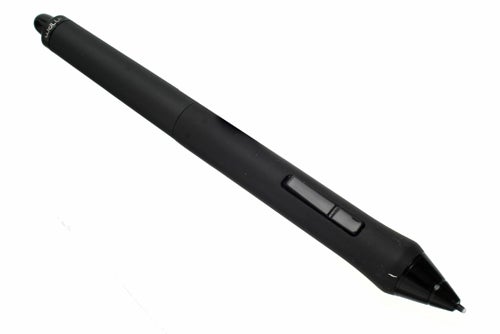
The provided pen is but one of a range of different available models, including specialised airbrush, inking and art pens. However, many will never need to upgrade from this standard model. It’s a soft-touch black affair with a rubber grip, and is both large and eminently comfortable in the hand. It offers tilt-sensitivity, a programmable rocker switch, pressure-sensitive eraser on its top and a nib that requires a mere gram of pressure to activate. Nibs are interchangeable to mimic various tools from pencils to markers, and Wacom provides ten nibs as well as a nib removal ring in the pen’s container stand.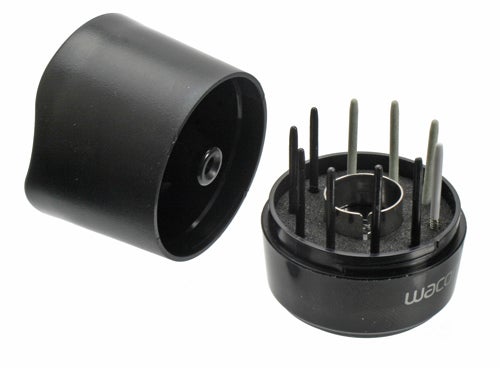
Naturally, the new Cintiq now provides 2,048 pressure levels to match its Intuos 4 sibling’s sensitivity, more than doubling those found on its predecessor. Unfortunately this only applies to the 21in 21UX model – the 12in, widescreen 12WX is still the equivalent of an Intuos 3 tablet, a situation we hope Wacom will soon remedy – especially since this smaller model has a Hanvon SenTIP rival, which we’ll be taking a look at soon. 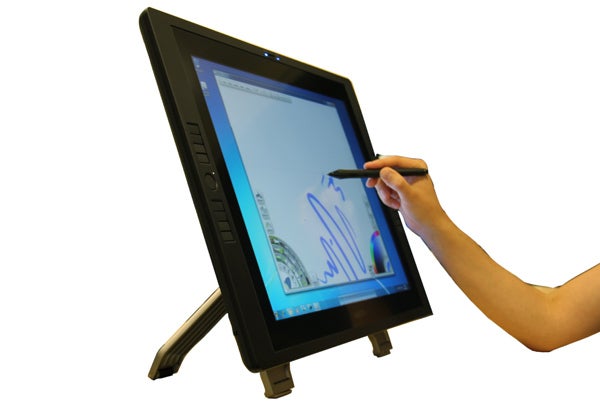
So what is different between the Intuos and Cintiq ranges, aside from the obvious screen aspect? Well, the OLED key indicators haven’t made it across, and we do miss these a little. However, to ease the loss, Wacom has designed the 21UX’s programmable buttons (called ExpressKeys) so that a press brings up a screen overlay showing all the various functions.
The Cintiq 21UX also rather spiffily doubles the Intuos 4’s eight ExpressKeys, selection wheel and zoom ring, by having a set on both sides. The zoom rings are now back to straight strips, and can be found behind the ExpressKeys on either side of the monitor’s bezel. Since this largely eliminates the potential for accidental activation (except when adjusting the screen’s rotation) that plagued the arrangement on the Intuos 3, we actually prefer this arrangement.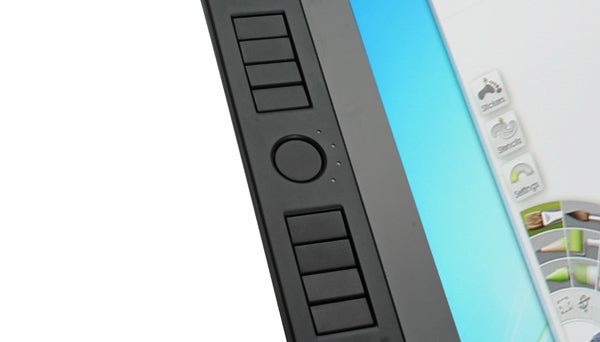
Wacom’s excellent driver is as easy to install and use as ever, and allows you to assign a multitude of tasks and commands to all 16 buttons, the wheels and strips. With this many options, you may not need to touch your keyboard at all!
Wacom has really done an excellent job with the Cintiq’s glass surface too. It feels just like drawing on the Intuos, meaning it’s as close to paper as you’re likely to get without using the actual article. From fine, delicate strokes to harsh lines, using this monitor/tablet hybrid never feels less than superb, and – unlike early Intuos 4 surfaces – the screen doesn’t scratch or wear easily. 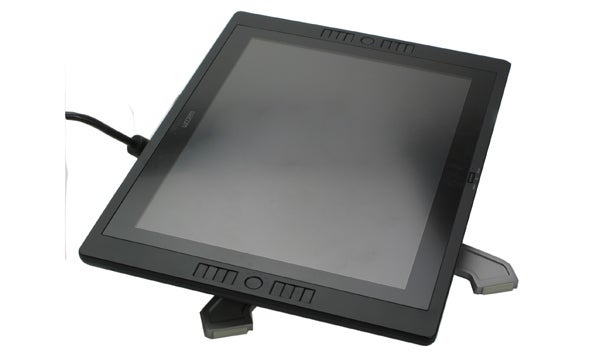
Of course, the price of entry for all this goodness is significant. You’re looking at around £1600 – that’s enough to buy a high-end 27in 2,560 x 1,440 IPS monitor, hardware colour calibrator and Intuos 4, plus some decent software. So the 21UX certainly isn’t for everyone, especially as it’s not great as a general-purpose monitor thanks to its 4:3 aspect ratio and sub-Full HD resolution.
However, if you do draw for a living or you have the money to fritter away, there simply is no similarly-sized rival that lets you ‘see what you draw as you draw it’. Since Wacom’s own 12in Cintiq uses older pen tech, the only viable alternative is Hanvon’s significantly smaller SenTIP, which we have yet to assess. It’s also worth keeping in mind that Wacom will be updating its Cintiq line soon, and we’re hopeful a 24in widescreen model might be on the cards.
Verdict
Wacom’s Cintiq 21UX tablet/monitor hybrid is the best digital artist’s tool available, but lacks the appeal of the company’s Intuos 4 thanks to its weight, limitations as a screen, and wallet-killing price. It has no rivals, but most will be better off buying a traditional tablet and separate monitor, and saving themselves a lot of cash into the bargain. If in the future Wacom lowers the price and makes its larger Cintiq more viable as a primary or companion monitor by using a higher-resolution widescreen panel, it will have a winner on its hands.
Trusted Score
Score in detail
-
Design 8
-
Value 6
-
Features 9

